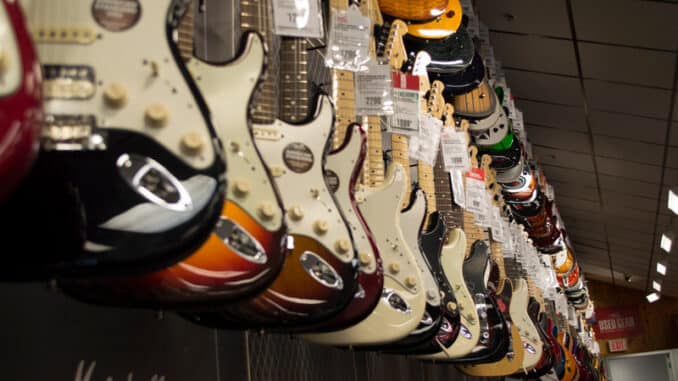
Oh man oh man oh man. Isn’t this a fun one? Today we are going to be examining the top 5 most underrated guitars of all time. That’s right, no longer are you going to have to hear the utterly outrageous claim your drinking buddy constantly makes that his Mayones Regius 6 Mosiac is the best guitar ever gifted upon mankind. You should hear it through his Orange half-stack, the tone is so dark it could only have been crafted in the fires of Mt. Doom.
But in all fairness, this article is just my opinion. There are no “underrated points” given to each piece of gear when it’s built, and there is no definite way to rank how underrated gear is. Keeping that in mind, I chose not to focus on smaller boutique brands. Yes, I know that many times, boutique gear tends to be a lot more interesting and downright better than international distributors, but I wanted to keep this article accessible for as much of the guitar playing community as possible. If you’ve spent time learning about guitar culture, you’ve probably heard of most of these guitars or brands, but paid them no mind or dismissed them due to their brand. Well, it’s time to look again, because here is the number five most underrated electric guitar of all time.
5. Epiphone Special Model Special II
Okay, I’ll go ahead and admit it: I’m a little biassed on this one. See, back in the tender year of 2004, after two years of only playing acoustic guitar, I purchased an Epiphone Special II with my savings from pet sitting across the neighbor. I believe it cost $249.99 at the time, and when I handed the vendor $250 in cash (mostly five’s), he handed me back a penny, gave me a wink, and told me this was a lucky penny; that I was not to lose it. Well, I lost that penny long ago, but still have held on to this guitar. For the price, this quite a well-playing guitar; it survived the awkward Linkin Park and Incubus stages, took on drop C tunings during the metal days, and began my journey into the blues phase.
In fairness of this article, this is not the most underrated guitar that Epiphone produces. If readers would be kind enough to follow a link to this website, they would see the specs for the Epiphone Les Paul Standard. Though many people rightfully claim that the Epiphone take on the classic Les Paul will never rival the Gibson original, the Epiphone Les Paul Standard still merits, at last, a play at your local music shop, for curiosity’s sake.

The Les Paul Standard guitar will typically run at $400, about twice as much as the Special II. Of course, both can probably be found used online or at a local music shop for cheaper. Both of these guitars do a fairly good job of replicating the famous Les Paul warmth, but there is a reason both are remembered to most as a knockoff rather than a tribute.
4. Ibanez AR325
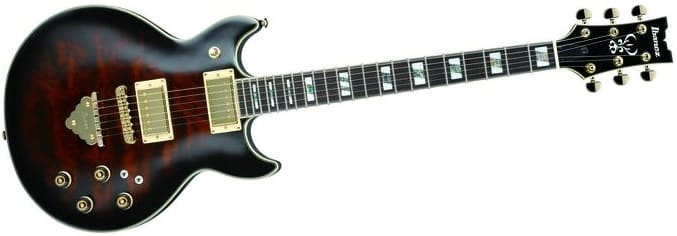
For some reason, Ibanez creates a major schism in the guitar-verse. Sure, there are some players who would sweat their lives away for it, but others can’t help but associate the name Ibanez with that nasty spit that comes to your mouth only when something truly disgusts you. You know, that spit. But even those players should try to give the Ibanez AR325 a chance.
To begin, just look at it. I mean, that’s a sexy guitar. The guitar comes in Transparent Red and Dark Brown Sunburst (pictured above). You can check out the specs on Ibanez’s website.
Really though, I think its the combination of the golden hardware on that just downright smooth chocolate sunburst mahogany body. Combined with the elegant, classic style ART1 tailpiece, the tasteful headstock, and the pearl inlays, this guitar is really an aristocratic piece of work. It just has that timeless sense of elegance to it. The AR325 usually costs around $500, though obviously can be found.
3. Carvin CT324
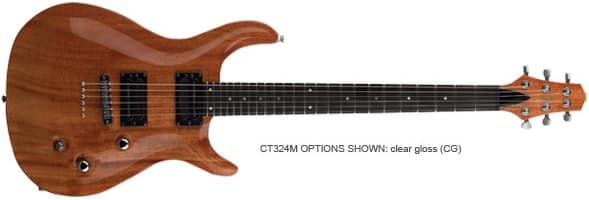
It’s true, Carvin players have a reputation. They are known for extreme brand loyalty; they know what they like (hint: they like Carvin) and they want to share it with anyone and everyone who is capable of listening. They are that one guy who just doesn’t realize that the conversion is on its knees begging, pleading to move on to a different topic, and so they just mercilessly shoulder through another 20 minutes explanation of why their Carvin Signature series has the most brutal tone (that’s why it’s a tribute to the Jason Becker).
Maybe that was a little harsh, but the point stands that Carvin players tend to really love their instruments. And why shouldn’t they? For metal guitarists, Carvin is a great option. Even Carvin’s forays into nonmetal instruments occasionally yield great results, like the CT324.
The smaller headstock and slightly offscale cutaways make this sleek, modern looking instrument, to my eyes. With only two knobs and a switch, the simple electronics and extremely natural Clear Gloss finish make this guitar a successful experiment in minimalistic guitar manufacturing. The Carvin CT324 definitely has an attractive and enduring design, and of course the playability of a Carvin. This guitar goes for about a grand on Carvin’s website, making it the most expensive guitar on this list, but one play and you’ll realize the CT324 is just as good any other guitar in the price range. Hell, if I had one of these, I would want to tell people about it all the time too.
2. Fender Squier Classic Vibe Stratocaster
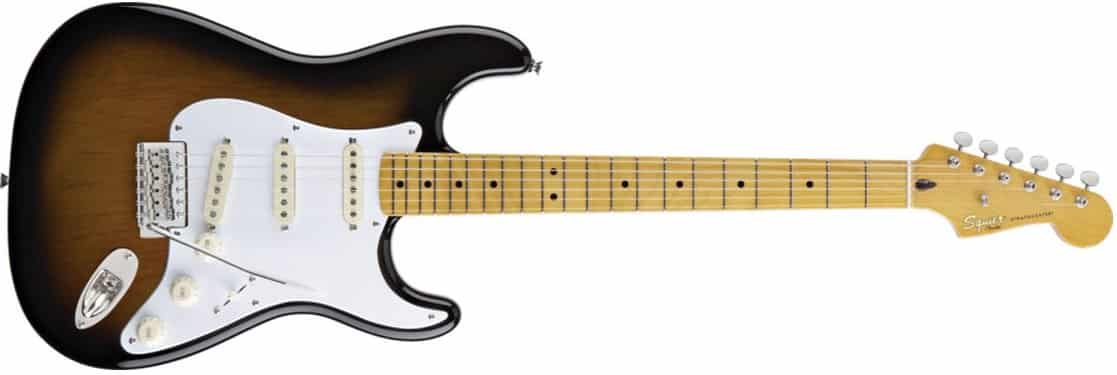
Honestly, there was once a time in my life when I scoffed at the name of Squier. Having no particular affiliation with Fender, not a single fiber in my being gave their junior brand any sort of a fair trial. And to be honest, I did have a bad experience with one; one of my best friends growing up was given a low-end Squier by his girlfriend at the time. What an awkward guitar that was, from the inconveniently shaped neck to the off-putting body weight to the scrawling signature and dedication of my friend’s girlfriend in the corner of the pickguard. I’ll be honest, that guitar sucked.
It wouldn’t be until several years later that I had a revolutionary experience with the Squier brand. Since my unfortunate jams on that cheap Squier, I had grown up and moved to Nashville to get my college education. Part of moving to another state with no prior contacts was establishing a new friend group; for awhile the only people I knew in the entire city my roommate and about two other people. It was during these sad, lonely days that I meekly thrust myself out on the internet. I posted a meager comment in a Nashville musicians forum asking if anyone wanted to jam, and soon I became connected with a guitarist and drummer living quite close to me.
It was through this guitarist that I first had a positive experience with a Squier. He allowed me to borrow his Squier Standard Strat regularly to experiment on, and my perception of Squier changed. Though the Standard Strat reintroduced me to the Squier world, it would be my time spent playing a Classic Vibe series Strat that would win the coveted position of number two most underrated guitar of all time. The 50’s Classic Vibe is pictured above, in all its classic attractive glory. As far as tone goes, the Classic Vibe definitely does a good job replicating the original 1950’s era Stratocasters, but it is certainly a long way away from those legendary guitars. As far as playability goes, however, this Squier seems to play less like a Start and more like a Tele, with a quick, powerful fretboard. These Classic Vibe Strats start at $580 on Fender’s website, expect somewhere in the neighborhood of $350 for a decent used one.
1. G&L ASAT Classic Bluesboy
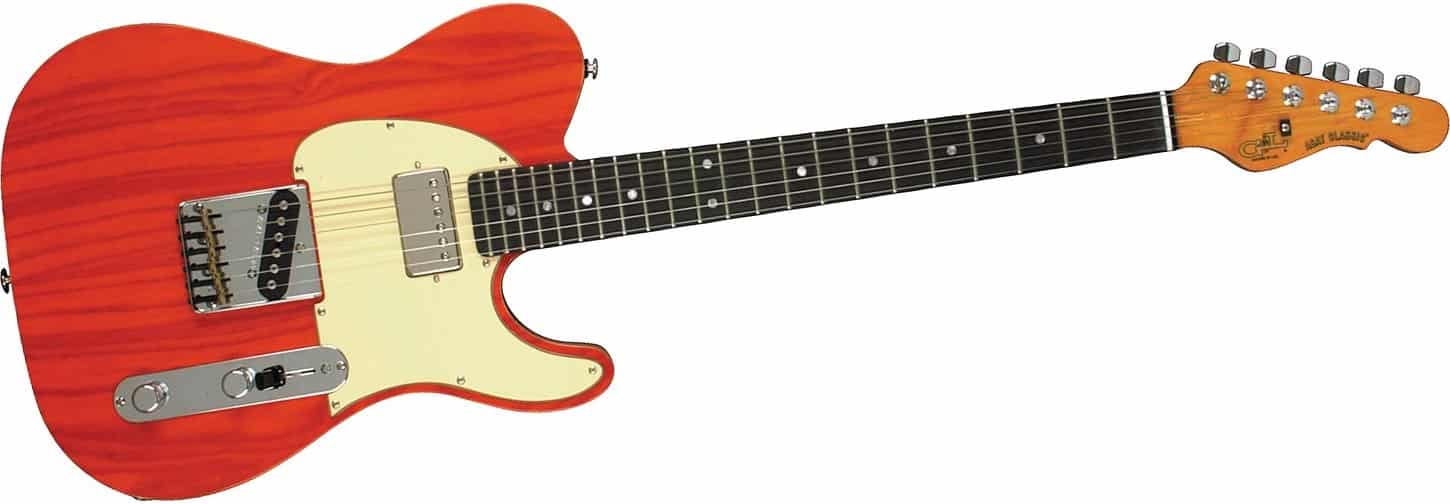
It only seems fair that if something by Squier should appear on this list, then G&L, another of Leo Fender’s companies, should make an appearance as well. For those a little shaky on their history, yes that is the same Leo Fender responsible for Fender guitars. During the late 70’s, Leo Fender grew increasingly hostile towards his job designing instruments for Music Man, so in 1979 he started his own company with George Fullerton, creating G&L.
The thing to remember with G&L guitars is that they are the updated versions of classic Fender guitars. Even though G&L has garnered some respect in its own right, it is still dwarfed by the success of Fender. Somehow, that influences a lot of musicians to see G & L as a knockoff of Fender. But this is simply not true, and the G&L ASAT Classic Bluesboy is a perfect example of why not.
The guitar plays just as smoothly as the seemingly orange finished swamp body looks, and that’s saying something. That orange is definitely bordering the fine line of too much orange, but off-white pickguard and boxed steel ashtray of a bridge give the guitar a vintage shine. The treasure of this guitar though is the headstock, which has an elegant shape, even if it does look a good bit like a bottle opener. At least it makes this ASAT look a little different than a Tele, even if they play and sound quite similar.
So there you have it. The top 5 most underrated guitars of all time. Now I’m sure that my list is different than just about every reader, and I would love to hear what you guys can come up with. Feel free to leave a comment about your top 5, or for discussion about this article.


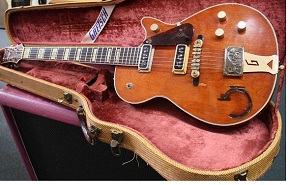
![John Lennon Revolution 3 Casino Guitars Lennon Played [Review] 9 john-lennon-epiphone-1965-casino-guitar](https://gear-vault.com/wp-content/uploads/2009/11/john-lennon-epiphone-1965-casino-guitar.png)
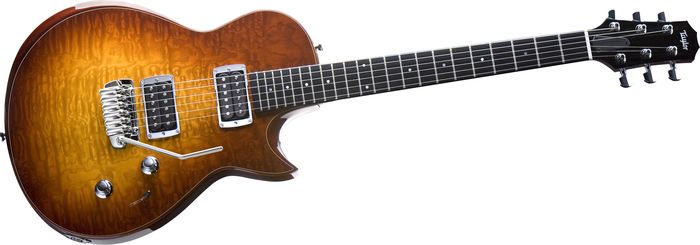
There are 3 guitars on your top five list that I would agree that are deeply underatted, 2 well not so much. Won’t name them, hate pointing fingers at a product, a lot of times it gives that product a bad name without really trying to do so. You suggest that we might leave our own 5 underatted guitars list…..I won’t leave five (although I could leave about 20) but; I will leave two..the Washburn HB35 and the Malden Bad Karma, I feel are great guitars for the buck. As a matter of fact the aforemention guitar companies consistantly make fine guitars as a whole.
I’m glad you agree with at least three of them, it’s definitely hard to write a top 5 list that only receives positive feedback. I’ve actually been spending a lot of time over the last few months using a Malden Mozak, it truly is a great and underrated instrument but I felt that including my current main guitar might be a little unfair.
As for Washburn, I’ve yet to have much experience with their guitars, but I do have a banjo they produced that is quite a fun little instrument.
As always, thanks for your feedback, check back in the next week or so for new content!
Jack,
I understand what you’re saying. Kind of surprised to hear that your main guitar is a Malden. Was kind of thinking that I was the only person within a 500 mile radius, who own some of these fine instruments. I have been loving, playing, GASing on guitars since the mid ’60s and I will tell you I’ve played a lot of different brands. High-end, mid-level, low-end, some good, some bad. The reason that I chose those two for the list is that after having so much experience with so may brands, Washburn and Malden guitars (for me) stand out as some of the best I’ve played. I own 4 Maldens, 3 Bulldozers, 1 original Karma, fine guitars all, as for Washburn, a HB35 and a Rover. I expect to purchase a HB32 later this year. I hope this does not sound like an endosement or a commercial for these two brands, I don’t write much, commenting on articles that much on the web, but; this article caught my eye. I look forward to any of your future articles. This has been a great subject.
Terrible writing, and get an editor for f#+ks sake, there are more typos than in a Jr high computer class
And…the first commentary is spot on. Washburn as a brand is one of the most underrated, if not the most.
Jeigh, I’d like to see your work. Judging by your comment, you’re not that spectacular of a writer either.
Yamaha Pacifica or RGX are both highly underrated.
Both in terms of play-ability and rival anything I’ve owned from a 67 custom shop Strat to a Wolfgang Special to a custom Suhr.
Suhr has to be one of the most underrated guitars on the market. I’d take one of those over Fender any day.